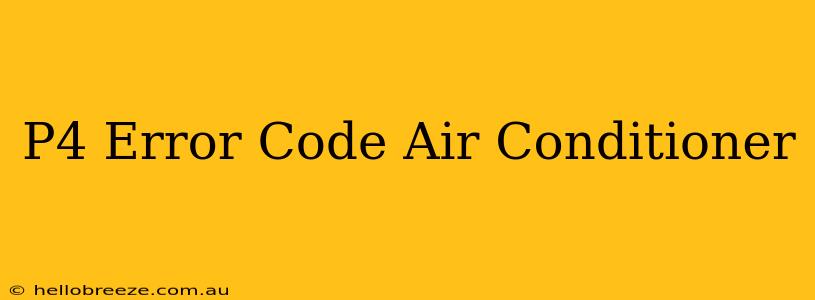Is your air conditioner displaying a dreaded P4 error code? Don't sweat it! This comprehensive guide will walk you through understanding the meaning of this error, troubleshooting the issue, and finding potential solutions. We'll cover common causes, preventative measures, and when it's time to call a professional.
Understanding the P4 Error Code
The P4 error code varies slightly depending on your air conditioner's brand and model. However, it generally points to a problem with the refrigerant system. This is a crucial component responsible for cooling your home. A P4 error often indicates a low refrigerant level or a refrigerant leak. Ignoring this error could lead to significant damage to your AC unit and potentially void your warranty.
Common Causes of the P4 Error Code
Several factors can trigger a P4 error code. These include:
- Refrigerant Leak: This is the most common culprit. A small hole or crack in the refrigerant lines can cause a slow leak over time, eventually leading to a low refrigerant level. Leaks can be difficult to detect, requiring specialized equipment.
- Compressor Issues: The compressor is the heart of your AC unit, responsible for circulating the refrigerant. A malfunctioning compressor can impact refrigerant pressure and trigger the P4 error.
- Clogged Filter: While less directly related, a severely clogged air filter restricts airflow, putting extra strain on the system and potentially leading to refrigerant issues.
- Condenser Coil Problems: The condenser coil releases heat from the refrigerant. Dirty or damaged coils can reduce efficiency and contribute to a P4 error.
Troubleshooting Your Air Conditioner's P4 Error
Before you panic, let's troubleshoot the problem systematically:
1. Check the Air Filter
This is the easiest step. Locate your air filter (usually accessible behind a panel on your unit) and inspect it. If it's dirty or clogged, replace it with a new one. This simple fix might resolve the issue.
2. Inspect the Condenser Coil
Locate the outdoor condenser unit. Carefully examine the condenser coil for debris, dirt, or any signs of damage. Gently clean the coil with a coil cleaning brush or a garden hose (low pressure). Avoid using harsh chemicals.
3. Check for Obstructions
Ensure there's adequate airflow around the condenser unit. Clear any obstructions like leaves, weeds, or debris that could restrict airflow and impact the system's performance.
When to Call a Professional
If the simple troubleshooting steps don't resolve the P4 error, it's crucial to call a qualified HVAC technician. Refrigerant leaks are particularly dangerous and require specialized equipment and expertise to repair safely. A technician can:
- Identify the exact cause of the error: They have the tools and knowledge to diagnose the problem accurately.
- Repair refrigerant leaks: This requires proper handling of refrigerants and specialized tools to locate and seal leaks.
- Repair or replace faulty components: If the compressor or other components are damaged, a technician can perform the necessary repairs or replacements.
Preventing Future P4 Errors
Regular maintenance is key to preventing future P4 errors and ensuring your air conditioner's longevity:
- Schedule annual maintenance: A professional inspection and cleaning can identify potential problems before they escalate.
- Change air filters regularly: Following the manufacturer's recommendations for filter changes will prevent airflow restrictions.
- Keep the condenser unit clean: Regularly clear debris and obstructions around the outdoor unit.
By understanding the P4 error code, performing basic troubleshooting, and scheduling regular maintenance, you can keep your air conditioner running smoothly and avoid costly repairs. Remember, safety is paramount, so don't hesitate to contact a qualified HVAC professional if you're unsure about any aspect of the troubleshooting process.

